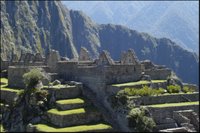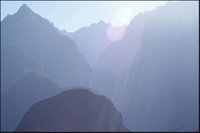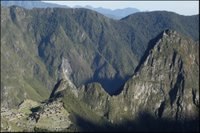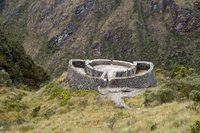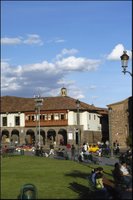
I recently visited San Francisco. This was my second visit, but this was my first chance to get a sense of the breadth and depth of what the city has to offer.
I stayed at the Hotel Adagio, which I highly recommend. It is more affordable than some of the name hotels, and conveniently located. The only caveat: it is right on the edge of the Tenderloin District. It isn't a problem at the hotel...just don't go right when you exit the hotel, because the quality of your experience will deteriorate rapidly.
The hotel is close to Union Square, which seems to be a hub of activity, and not far from the Metro sub station, which will take you just about anywhere you want to go for $1.50. That's the statue in Union Square. You can see the fog, which is a daily feature that does not lift until at least 10 a.m. Bring a sweater. It's always cold in the morning.
 If you hang a left at Union Square, you'll soon be near Chinatown. I mostly walked the streets in Chinatown, soaking up atmosphere. I went into a couple of shops. Very touristy and over priced. Avoid the electronics stores, where they will flat out lie to you about what will work on your camera. One guy tried to sell me a lens for my camera that I knew wouldn't work. He started out at $500, and reduced it to $35 "just for me."
If you hang a left at Union Square, you'll soon be near Chinatown. I mostly walked the streets in Chinatown, soaking up atmosphere. I went into a couple of shops. Very touristy and over priced. Avoid the electronics stores, where they will flat out lie to you about what will work on your camera. One guy tried to sell me a lens for my camera that I knew wouldn't work. He started out at $500, and reduced it to $35 "just for me."If you hang a right at Union Square, you'll go past a number of stores (e.g., The Gap) before arriving at the Metro station. You can go a long way on the train. In one direction, AT&T Park, where the San Francisco Giants play.
 That's worth a visit even without Barry Bonds.
That's worth a visit even without Barry Bonds.In another direction, Golden Gate Park, a huge park on the order of
 Central Park in New York, with public art, museums, botanical gardens and lots of people having fun. This pink head is one of the public art works on display, and the Conservatory of Flowers has an
Central Park in New York, with public art, museums, botanical gardens and lots of people having fun. This pink head is one of the public art works on display, and the Conservatory of Flowers has an interesting collection of orchids, venus fly traps and pitcher plants.
interesting collection of orchids, venus fly traps and pitcher plants.For a completely different experience, take the Metro to the Mission District and walk around. Dip into alleys here and there to find some amazingly high quality graffitti. Here are examples of the graffitti and murals: Clarion Street alley, The Generator and Balmy Alley. Get a taco at one of the many taqueria's while you are in the Mission District.



Why the Metro, and not these beautiful streetcars? Because the streetcars are for tourists. They are slow, packed with people, and
 expensive ($5, each way). They also have a limited range of places to take you, and sometimes they decide not to stop at each scheduled stop. I rode one about half the distance advertised, because they decided not to make the other stops. We could catch another streetcar to keep going. It would be another $5. Makes a good picture, but avoid the ride.
expensive ($5, each way). They also have a limited range of places to take you, and sometimes they decide not to stop at each scheduled stop. I rode one about half the distance advertised, because they decided not to make the other stops. We could catch another streetcar to keep going. It would be another $5. Makes a good picture, but avoid the ride.Consider renting a bike. I used Blazing Saddles. I rented a bike for the day (about $35 for a high end mountain bike) and road across the Golden Gate Bridge. Here's a shot from the foot of the bridge. The only time it is strenuous is getting from this point up to the road where the bridge begins.

The bridge ride itself is safe and easy. There's a riding area that protects
 you from the cars. It is full of people walking, though, so you sometimes have to slow down a bit.
you from the cars. It is full of people walking, though, so you sometimes have to slow down a bit.On the other side, you can swing right into the town of Sausalito, which is also full of people. It's restaurants cater to tourists, though you can ask the natives where to eat and they'll send you on the side streets for higher quality fare. If you swing left off the bridge, you can take your bike into the trails of the Marin Headlands.
 You'll find yourself in the hills above the ocean, with the top of the Golden Gate at eye level.
You'll find yourself in the hills above the ocean, with the top of the Golden Gate at eye level.Not for the weak. Very, very strenuous climb on the road to the Headlands, and on the mountain biking trails. Some beautiful
 scenery makes it worth it. You can swing around in a loop to finish up in Sausalito. Then take the ferry back to the city. Blazing Saddles will sell you the ferry ticket when you rent the bike.
scenery makes it worth it. You can swing around in a loop to finish up in Sausalito. Then take the ferry back to the city. Blazing Saddles will sell you the ferry ticket when you rent the bike.


